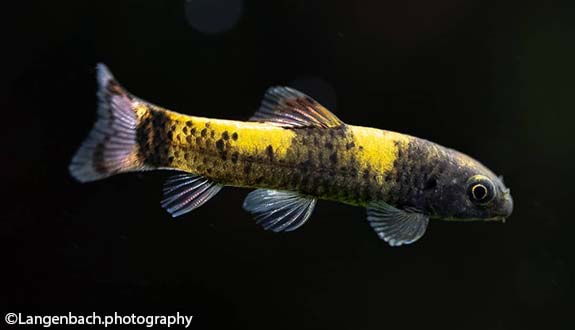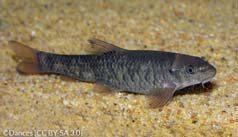

Alternative species (click on the thumbnail to see the card)
Names
Scientific name
Garra flavatra
Common name
Panda Garra
Origin

Origin: Southeast Asia (Burma)
Biotope: Asian
Dimorphism

Males are slightly thinner than females. As adults, they have small rounded protuberances on the head, around the caudal peduncle and along the lateral line.
Group

Cyprinidae
Volume

150 L / 33 imp gal / 40 US gal
Parameters

T°: 19 to 25°C or 66 to 77°F
pH: 6.9 to 7.1
Hardness: 5 to 12°dGH
Difficulty

Average
Size

5 to 7cm (2 to 2.8")
Longevity

3 to 4 years
Living zone

Depth
Individuals

6
Food
How to feed the Panda Garra?
Food
How to feed the Panda Garra?
Contrary to the widespread commercial arguments that this fish is a good algae eater, this is not the case. In fact, it will only consume a small amount of algae. It is rather fond of the biofilm covering the decor or the windows, which it scrapes off with its "suction cup" mouth. The purchase of a Garra to eradicate an algae invasion is therefore not relevant, and you will be disappointed with the result. We rather recommend that you review your maintenance and brightness settings.
To feed your Garra, offer him groundfish pellets with spirulina, zucchini, cucumber, peas... Complete this vegetable food by offering him small live prey (if not frozen) such as bloodworms, artemia, tubifex, shrimp pieces...
Behavior
What kind of behavior does the Panda Garra have?
Behavior
What kind of behavior does the Panda Garra have?
Generally speaking, the Garra flavatra is a fast, lively and very active fish (even playful and teasing)! It is also very curious! It will know how to put life in your aquarium! Nevertheless, it remains very peaceful and without aggressiveness (small dominance jousts but nothing very worrying). Provide shady resting areas: it will rest on large leaves, roots...
It lives mostly close to the ground, even if it will regularly wander in other areas of the tank. Set up resting areas on all floors.
Be careful when cleaning your aquarium as they will gladly stick to your hand! Indeed, they are not shy at all and will bicker to come and stick to you! Needless to say, do not put hand cream or any other chemical product on them before putting them in your aquarium.
Cohabitation
Who can live with the Panda Garra?
Cohabitation
Who can live with the Panda Garra?
A gregarious fish, it needs the company of a few other species to flourish. Thus, a small group of at least 6 specimens is recommended. However, it does not form a shoal strictly speaking, but each one lives its life on its own, while keeping an eye on the rest of the troop.
Very sociable and peaceful, it will easily find its place in a community aquarium. Moreover, no particular cohabitation restrictions are to be reported for this species, except for its water needs. Ideally, associate them with species from their biotope that appreciate fresh water (non-exhaustive list): Devario, Danio, Puntius, Gastromyzon and Sewellia, Botia and Acanthocobitis, Homaloptera, Barilius, Schistura...
Breeding
How to breed the Panda Garra?
Breeding
How to breed the Panda Garra?
Isolate a mature couple in a previously prepared 80 litre / 18 Imp Gal / 21 US Gal aquarium. It will contain the same water as the main aquarium (pH of 7 if possible) and will be equipped with an external filter (remember to protect the suction strainer so that the fry are not sucked up).
Spawning usually takes place in the morning. Fertile eggs will be translucent and about 1.5/1.8 mm in diameter. Incubation lasts between 24 and 30 hours depending on the temperature. After hatching, free swimming of the fry appears after 72 hours. For optimal growth, the water must be highly oxygenated.
Food for the fry: boiled egg yolks then after 1 week artemia nauplias.
Its aquarium
Which aquarium for the Panda Garra?
Its aquarium
Which aquarium for the Panda Garra?

In the wild, it lives in small streams with clear water. For maximum comfort, recreate a river decor in your aquarium. To do this, compose your floor with smooth pebbles (as if they were eroded by the current) and small round pebbles of different sizes, all on a bed of sand or fine gravel (in any case, no sharp ground for this barbelled species!). For the rest of the scenery, make an interlacing with branches of driftwood. Finish this decor by attaching Anubias, Bolbitis or Java fern to the decor.
Don't skimp on the light that will encourage the growth of the biofilm that the Garra is so fond of.
As for the quality of the water, it must always remain clear, well oxygenated and very clean, like a river. For this, a good filtration system is necessary (external in the ideal case). Do not hesitate to generate a good current because the Garra appreciate swimming in it! However, limit the current area to leave more quiet resting places. On the temperature side, if the range of tolerance seems wide to you, note that this fish prefers rather fresh water most of the time. However, the temperature can rise significantly in the summer without worrying you, as this is how it lives in its natural environment. As far as pH is concerned, the tolerance range is 6.5 to 7.5, but with an optimal pH of 6.9 to 7.1.
Cover your aquarium because these fish can quickly get out of it (they are able to rise out of the water!). Beware, this is a sign that something is not right for them in their aquarium!
Good To know
Find all additional information!
Good To know
Find all additional information!
The Garra flavata is classified as a "near-threatened" species because of the degradation of its environment by human activities.
It uses its pair of barbels to search for food in the soil. It thus locates the food it moves and ingests it!
There are 146 species of Garra currently described!
Even if it is robust and not very fragile, the creation of optimal living conditions for this species still requires a little experience in aquaristics.
Yours photos!
Comments
Sort by:
Please login to post comments


